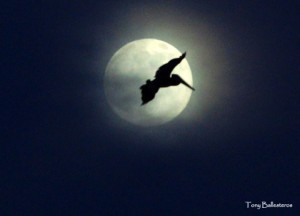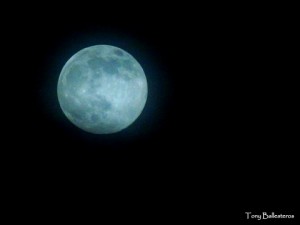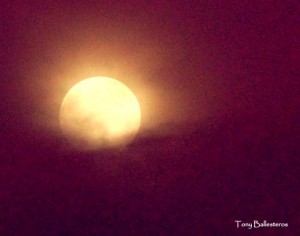If overcast skies spoiled your view of the much hyped July 12th ‘Supermoon’, no problemo, amigo. You’ll have not one, but two more opportunities this year to gaze at, photograph, or otherwise enjoy the phenomenon of a Supermoon. The photos in this blog entry are of the July Supermoon, taken by our friend and local photographer, Tony Ballesteros, who endured through the wee hours of July 11th to capture these awesome images. Thanks Tony! 
What is a supermoon?
The label supermoon was coined over 30 years ago by Richard Nolle —an astrologer, no less—although it didn’t hit prime time usage by astronomers until just a few years ago. No real reason why it didn’t become widely used right away since Nolle’s definition of a supermoon was a clear, concise description of what astronomers call a perigee full moon or perigee new moon. Perigee simply means “near earth.” Because the moon’s orbit around the earth is elliptical there’s a point when it is nearest the earth and a point whe n it’s furthest from the earth. When its near point coincides with a new or full moon, that is a Supermoon. Nolle even defined the distance to the earth that would qualify a moon as a supermoon. He said that a supermoon is a new or full moon which occurs with the moon at or near (within 90%) its closest approach to Earth in a given orbit. The distances are measured from the center of the moon to the center of the Earth. That generous 10% leeway allows for many supermoons by definition, anywhere from 4 to 6 per year.
n it’s furthest from the earth. When its near point coincides with a new or full moon, that is a Supermoon. Nolle even defined the distance to the earth that would qualify a moon as a supermoon. He said that a supermoon is a new or full moon which occurs with the moon at or near (within 90%) its closest approach to Earth in a given orbit. The distances are measured from the center of the moon to the center of the Earth. That generous 10% leeway allows for many supermoons by definition, anywhere from 4 to 6 per year.
In fact, this year, counting the July 12th Supermoon we’ve already had three of them. The first two were new moons that occurred on January 1st and January 30th. Of course we couldn’t see them as new moons occur when the moon is aligned between the earth and the sun. We still have two more full moons to go which will be Supermoons according to Nolle’s definition. The next one is on August 10th and the final, and fifth of the year is on September 9th, another full moon. The full moon of next Sunday, August 10th is actually the one that will be closest to the earth and will appear as the largest and brightest. It will also cause the largest surges in the earth’s tides. (Full and new moons always affect our tides because our planet receives extra gravitational pulls from both the sun and the moon. 
So, how close will the August 10th Supermoon be to the Earth? On that night the moon will be 356,896 kilometers from Earth. For reference, when it is the furthest from Earth the distance is 406,567 kilometers, a difference of 49,671 kilometers.
So, get your cameras, binoculars, telescopes…or beach chairs and enjoy the bright moon on Saturday the 10th. If you’re a meteor shower watcher, please note the supermoon will fade out all but the brightest of meteors from the Perseid showers that happen this time each year.
Even though they don’t have much to do with Supermoons, we’ll leave you with these final two interesting facts that you may not know about our earth and the moon:
Earth:
Did you know that in our orbit around the sun, we’re hurtling through space at nearly 67,000 mph? At the same time our planet is spinning around in circles at over 1000 mph! Almost makes you dizzy, doesn’t it?
Moon:
Did you ever wonder why we always see the same side of the moon from here on Earth? It is simply because the rotation period of the moon is identical to its orbital period (29.5 days). Hence we always see the same face of the Moon!
This blog is powered by www.sonoranresorts.mx, Jim Ringquist, Director of Sales and Marketing.

